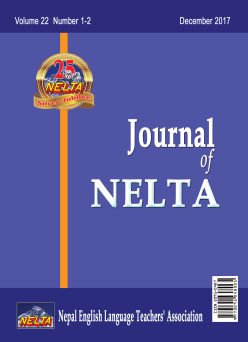Using the First Language (L1) as a Resource in EFL Classrooms: Nepalese University Teachers’ and Students’ Perspectives
DOI:
https://doi.org/10.3126/nelta.v22i1-2.20039Keywords:
First language (L1), English as a foreign language (EFL), Speech acts, Code switchingAbstract
While challenging the widely held belief that students in English as a foreign language (EFL) classroom prefer their teachers not use the first language (L1), the study examined attitudes of university teachers and students towards using L1 and reasons for giving up on English and reverting to Nepali in English-medium lessons. Drawing on a mixed-method study that used survey questionnaire (N= 50) and interviews (N=15), the researcher identified a number of classroom speech acts that are performed by teachers’ and students’ in their L1. The findings revealed that both teachers and students had a positive attitude towards using L1; however, they held the belief that the overuse of L1 may impede language learning. Although the teachers seemed to discourage the use of Nepali (L1) in lessons aimed at developing learners’ communicative competence, they used Nepali to help learners comprehend complex concepts of grammar and lexis. Although the excessive use of Nepali was seemingly associated with teachers’ lack of communicative competence and creativity in delivering EFL lessons, students preferred their teachers to use the L1.
Journal of NELTA , Vol. 22, No. 1-2, 2017 December
Downloads
1103
929
Downloads
Published
How to Cite
Issue
Section
License
© Nepal English Language Teachers’ Association (NELTA)
Authors are required to transfer their copyright to the Nepal English Language Teachers' Association (NELTA)
The Journal of NELTA is copyright by Nepal English Language Teachers’ Association (NELTA). Apart from citing/referencing in academic works, no part of any materials may be reproduced by any process without prior written permission from its copyright owner – NELTA. Requests and enquiries concerning reproduction and rights may be addressed to NELTA or the editorial board at neltaeditorialboard@gmail.com.




